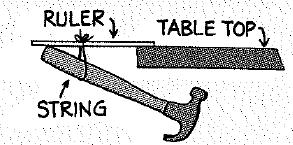
Concept explainers
Hang a hammer on a loose ruler as shown. Then explain why it doesn’t fall.

To Explain: The reason due to which the hammer does not fall.
Explanation of Solution
Introduction:
The center of mass of an object is defined as the position where the weighted relative position is zero.
The heaviest part of hammer is its head. When the hammer is tied with the string, the gravity force pulls the hammer down. This causes an upward force on the handle of the hammer. This force causes an upward force on the ruler which helps the ruler to balance on the table top. The center of gravity of the system lies just below the support, so the hammer does not fall as well.
Conclusion:
Thus, the hammer does not fall.
Chapter 11 Solutions
Conceptual Physics: The High School Physics Program
Additional Science Textbook Solutions
Chemistry: Structure and Properties (2nd Edition)
Chemistry & Chemical Reactivity
Physics for Scientists and Engineers: A Strategic Approach, Vol. 1 (Chs 1-21) (4th Edition)
Campbell Essential Biology (7th Edition)
Biology: Life on Earth (11th Edition)
Cosmic Perspective Fundamentals
- Example Two charges, one with +10 μC of charge, and another with - 7.0 μC of charge are placed in line with each other and held at a fixed distance of 0.45 m. Where can you put a 3rd charge of +5 μC, so that the net force on the 3rd charge is zero?arrow_forward* Coulomb's Law Example Three charges are positioned as seen below. Charge 1 is +2.0 μC and charge 2 is +8.0μC, and charge 3 is - 6.0MC. What is the magnitude and the direction of the force on charge 2 due to charges 1 and 3? 93 kq92 F == 2 r13 = 0.090m 91 r12 = 0.12m 92 Coulomb's Constant: k = 8.99x10+9 Nm²/C² ✓arrow_forwardMake sure to draw a Free Body Diagram as wellarrow_forward
 College PhysicsPhysicsISBN:9781305952300Author:Raymond A. Serway, Chris VuillePublisher:Cengage Learning
College PhysicsPhysicsISBN:9781305952300Author:Raymond A. Serway, Chris VuillePublisher:Cengage Learning University Physics (14th Edition)PhysicsISBN:9780133969290Author:Hugh D. Young, Roger A. FreedmanPublisher:PEARSON
University Physics (14th Edition)PhysicsISBN:9780133969290Author:Hugh D. Young, Roger A. FreedmanPublisher:PEARSON Introduction To Quantum MechanicsPhysicsISBN:9781107189638Author:Griffiths, David J., Schroeter, Darrell F.Publisher:Cambridge University Press
Introduction To Quantum MechanicsPhysicsISBN:9781107189638Author:Griffiths, David J., Schroeter, Darrell F.Publisher:Cambridge University Press Physics for Scientists and EngineersPhysicsISBN:9781337553278Author:Raymond A. Serway, John W. JewettPublisher:Cengage Learning
Physics for Scientists and EngineersPhysicsISBN:9781337553278Author:Raymond A. Serway, John W. JewettPublisher:Cengage Learning Lecture- Tutorials for Introductory AstronomyPhysicsISBN:9780321820464Author:Edward E. Prather, Tim P. Slater, Jeff P. Adams, Gina BrissendenPublisher:Addison-Wesley
Lecture- Tutorials for Introductory AstronomyPhysicsISBN:9780321820464Author:Edward E. Prather, Tim P. Slater, Jeff P. Adams, Gina BrissendenPublisher:Addison-Wesley College Physics: A Strategic Approach (4th Editio...PhysicsISBN:9780134609034Author:Randall D. Knight (Professor Emeritus), Brian Jones, Stuart FieldPublisher:PEARSON
College Physics: A Strategic Approach (4th Editio...PhysicsISBN:9780134609034Author:Randall D. Knight (Professor Emeritus), Brian Jones, Stuart FieldPublisher:PEARSON





